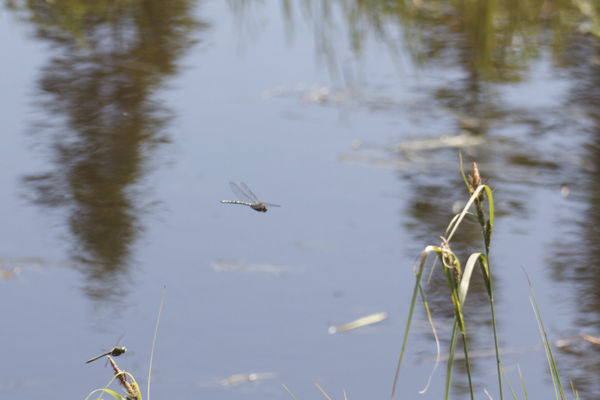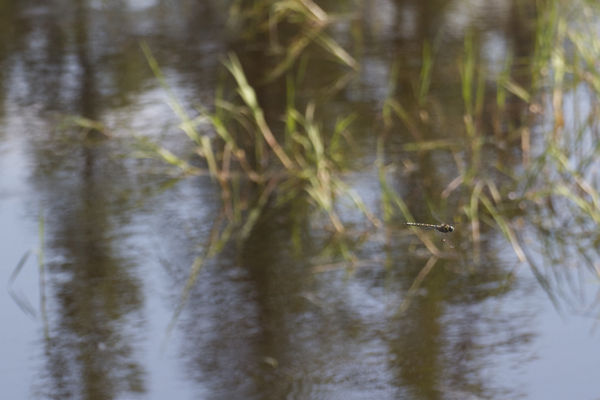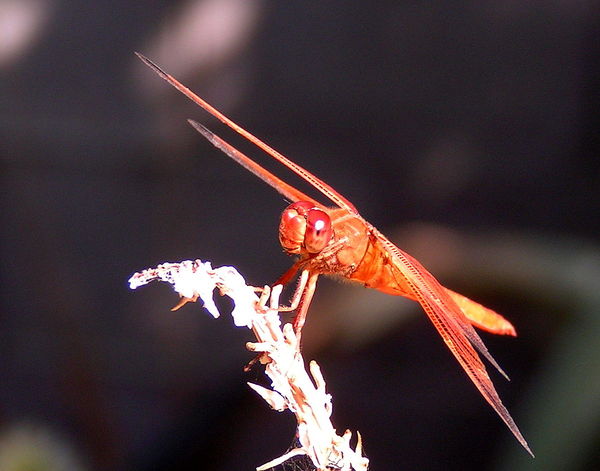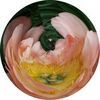dragonfly on the wing
Jun 23, 2012 19:16:20 #
iosa
Loc: Fairbanks, AK
Any suggestions on how I might try to bring a subject like this into sharper focus? I was handholding my camera, a Canon 7D fixed with a Tamron 70mm-300mm zoom (set to 147mm), f/7.1, ISO 640, using spot metering. The first shot was at 1/1000s, the second at 1/1250s.


Jun 23, 2012 20:16:16 #
iosa wrote:
Any suggestions on how I might try to bring a subject like this into sharper focus? I was handholding my camera, a Canon 7D fixed with a Tamron 70mm-300mm zoom (set to 147mm), f/7.1, ISO 640, using spot metering. The first shot was at 1/1000s, the second at 1/1250s.
That's a shot of a pond, not a shot of a dragonfly. You have to zoom in considerably to get the dragonfly. Fill your viewfinder with the subject.
This shot was taken at 1/400th, f/8, ISO 200, at 200mm with a 55/200mm kit lens.
http://tonycooper.smugmug.com/Photography/Miscellanea/i-tK4V3v9/0/XL/2009-04-23-9-XL.jpg
Jun 24, 2012 06:46:52 #
Cooper wrote:
quote=iosa Any suggestions on how I might try to ... (show quote)
This is a non sequitur example answer. The person is asking about flying dragonflies if I am not mistaken. A much more daunting task. My answer would be to watch and find a place they frequently land. Set up close by and be prepared to take a great many shots. There are ways to have sensors set up to trigger the camera when an organism passes through the beam, but they are more expensive and are also not as easy to rig up for invertebrates such as dragonflies. I saw a setup once that was constructed from a terrarium so that the invertebrate was restricted to movement. It still took many exposures to get just a single image.
Jun 24, 2012 08:28:28 #
Bozsik wrote:
quote=Cooper quote=iosa Any suggestions on how I... (show quote)
There's no mention of capturing a dragonfly in flight. The OP wants to photograph a dragonfly. If so, the OP has to get close and fill the frame with the dragonfly. Otherwise, it's a photo of a pond with a dragonfly in the scene.
Jun 24, 2012 10:41:19 #
iosa wrote:
Any suggestions on how I might try to bring a subject like this into sharper focus? I was handholding my camera, a Canon 7D fixed with a Tamron 70mm-300mm zoom (set to 147mm), f/7.1, ISO 640, using spot metering. The first shot was at 1/1000s, the second at 1/1250s.
If you use spot metering the very center of the image is what is in focus. It is probably a good idea also to set focus on single point manually selected. Select the centermost point to correspond with your metering. Shoot a burst of shots. The 7D is capable of 8 frames per second , therefore you should have a good chance of hitting the insect in the dead center of the frame at least on a few of your shots.
Jun 24, 2012 11:53:46 #
As their flight path is quick and "random" you might locate an aiming object in the scene, put your camera on a tripod and wait until the dragonfly nears the aiming object. Then fire a burst and hope for the best. Small quick moving objects are very difficult to photograph.
Try a slower insect or one which can be baited.
{The dragonfly is properly focused, but it may take more pixels to get an image that you can enlarge and crop }
Try a slower insect or one which can be baited.
{The dragonfly is properly focused, but it may take more pixels to get an image that you can enlarge and crop }
Jun 24, 2012 11:59:00 #
Jun 24, 2012 13:11:28 #
Jun 24, 2012 13:45:15 #
iosa wrote:
Any suggestions on how I might try to bring a subject like this into sharper focus? I was handholding my camera, a Canon 7D fixed with a Tamron 70mm-300mm zoom (set to 147mm), f/7.1, ISO 640, using spot metering. The first shot was at 1/1000s, the second at 1/1250s.
I would zoom in during PP to see if the DF is captured correctly. The need to get closer is obvious, but we're dealing with what you've submitted. I've been surprised what a good crop will do.
Jun 24, 2012 20:21:18 #
I suggest that you look at www.borgepedersen.net - you will find that I am using the same outfit as you except the Lens is Canon 28-300 L.
On my site you will find heaps of dragon flies, mainly laying eggs and in one case you will f ind them mating. I do have a few on the wing but even at 1/2000 you will find the wings blurred.
Now take your picture up to 100%. Most of the picture is therefore fresh air - so you will have to crop to make a reasonable picture. As for cropping such small things you just make sure that the critter fills the crop and then give a centimeter or so all around and that is the best you can do.
EGROB14
On my site you will find heaps of dragon flies, mainly laying eggs and in one case you will f ind them mating. I do have a few on the wing but even at 1/2000 you will find the wings blurred.
Now take your picture up to 100%. Most of the picture is therefore fresh air - so you will have to crop to make a reasonable picture. As for cropping such small things you just make sure that the critter fills the crop and then give a centimeter or so all around and that is the best you can do.
EGROB14
Jun 24, 2012 20:28:03 #
Thanks, DennisG and RWCRNC, for the comments on my photo.
My point was that the lens the OP is using is capable of getting a close and detailed dragonfly shot. I was using a similar lens.
Actually, I have the Tamron 18/300 lens, but I purchased that after taking the dragonfly shot.
It's harder to track a dragonfly in flight than it is to catch one perched on something. The trick is to watch the area for awhile and notice where they tend to land. They'll land and take flight again, but tend to land in the same place.
If the OP picks a spot to watch, and pre-sets the zoom to fill the frame at that spot, he'll have his shot within minutes. He should pick landing spot separated from the background so the bokeh is sufficiently blurred even at a fairly high f/stop up to f/8 or so.
The one in my photograph is a Blue Dasher.
My point was that the lens the OP is using is capable of getting a close and detailed dragonfly shot. I was using a similar lens.
Actually, I have the Tamron 18/300 lens, but I purchased that after taking the dragonfly shot.
It's harder to track a dragonfly in flight than it is to catch one perched on something. The trick is to watch the area for awhile and notice where they tend to land. They'll land and take flight again, but tend to land in the same place.
If the OP picks a spot to watch, and pre-sets the zoom to fill the frame at that spot, he'll have his shot within minutes. He should pick landing spot separated from the background so the bokeh is sufficiently blurred even at a fairly high f/stop up to f/8 or so.
The one in my photograph is a Blue Dasher.
Jun 25, 2012 15:41:19 #
Dragonflies will sit quietly while you photograph them. Wait till they light somewhere and then move in slowly (and close).

Jun 25, 2012 22:41:37 #
Lovely pic, Groucho!
Another trick with dragonflies is that you can edge up on them. They seem to like the same spot so as you close in, the bug will fly off, but stay really still, and it will return again. Crib a few more inches, wait a few more moments and so on. I've managed to get some awesome shots using this method. Of course, to get them on the wing, it's the same deal except you have to handle the camera a lot quicker :) Once again, you know they will return so be waiting for them.
Another trick with dragonflies is that you can edge up on them. They seem to like the same spot so as you close in, the bug will fly off, but stay really still, and it will return again. Crib a few more inches, wait a few more moments and so on. I've managed to get some awesome shots using this method. Of course, to get them on the wing, it's the same deal except you have to handle the camera a lot quicker :) Once again, you know they will return so be waiting for them.
Jun 25, 2012 23:05:20 #
Yes, they'll almost pose for you if you're patient:
http://dl.dropbox.com/u/64147677/2009-04-01-1.jpg
http://dl.dropbox.com/u/64147677/2009-05-10-1.jpg
http://dl.dropbox.com/u/64147677/2009-04-01-1.jpg
http://dl.dropbox.com/u/64147677/2009-05-10-1.jpg
Jun 29, 2012 22:10:42 #
Good luck. Had one flying around the swimming pool one afternoon that a tried to catch with a 30D. Out of 100 shots, I only got one that was reasonably sharp.
If you want to reply, then register here. Registration is free and your account is created instantly, so you can post right away.





